Nothing Ear (a) Review: Feature-rich in-ear earphone for the audiophile on a budget
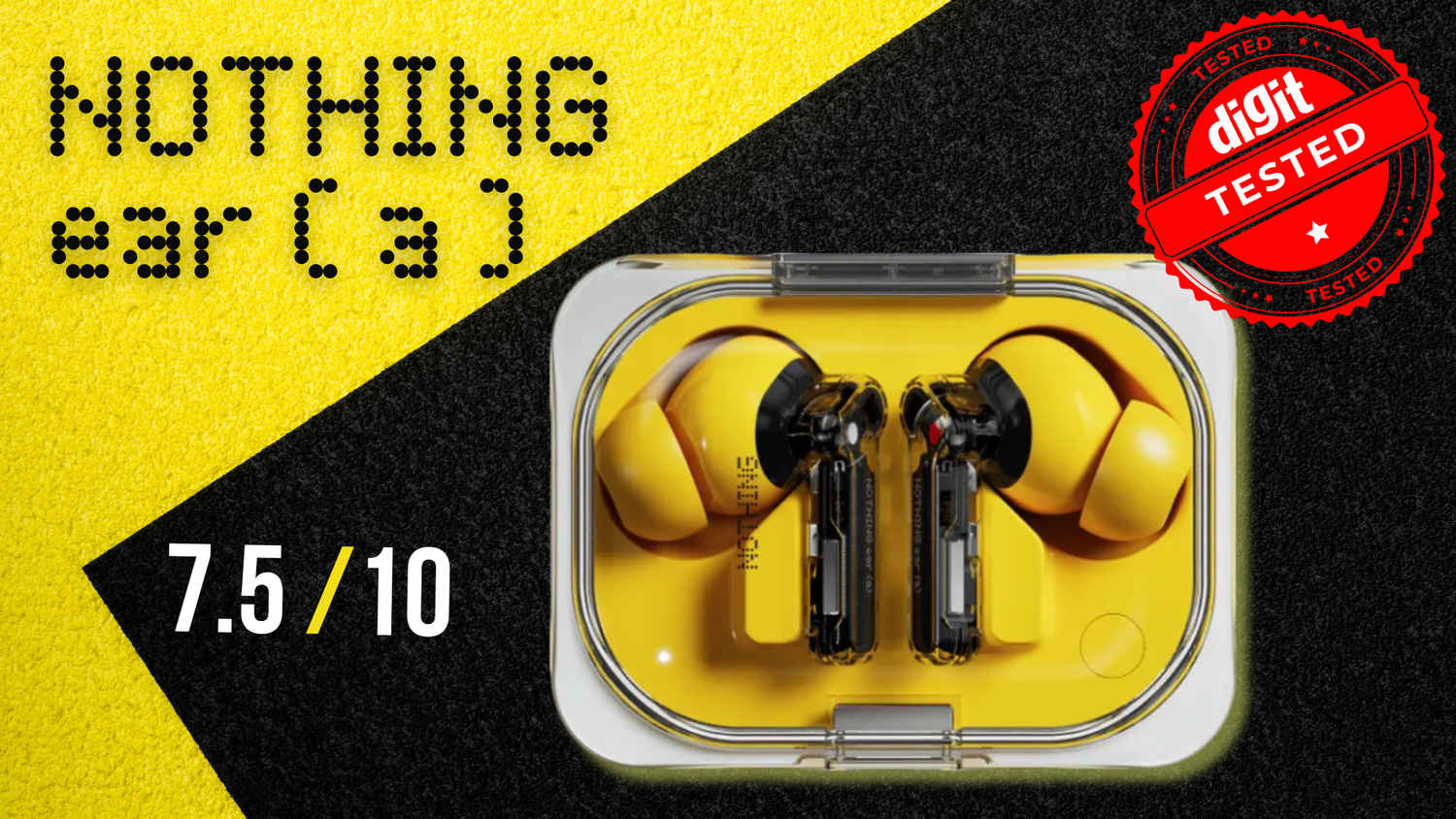
- Excellent fit
- Great feature set for the price
- Customisable EQ with the Nothing X app
- Polarising case design and colour scheme
- The bass-forward sound signature can be overwhelming for some
Nothing Ear (a) makes for a compelling option for people looking for a pair of TWS in-ear earphones with ample, well-implemented features, and if you are a fan of bass-heavy music or if you are someone who is willing to play around with the EQ to ensure that you get the sound that you desire. Out of the box, their sound is bass-heavy, and might not appeal to the purists, but the EQ in the Nothing X app, and the overall customisation experience provided by the app, definitely make up for all the lost ground.
If you are looking for alternatives, then the Audio-Technica ATH-SQ1TW and the Sony WF-C700N are your best bets. Both are priced similarly to the Nothing Ear (a). The Audio-Technica ATH-SQ1TW offer much better sound out of the box, but they trade out a lot of features that you get with the Nothing Ear (a). The Sony WF-C700N, offer similar sound out of the box and features. With those earbuds, the only place where you would be left in splits would be the aesthetics. And, that is up to you.
Coming to their pricier cousins, the Nothing Ear (2024), you get the extra bit for which you would pay. So, if you have the budget, go for them over the Nothing Ear (a). However, read our review before doing it!
Nothing, after the launch of the Nothing Ear 1, solidified their position in the mid-range TWS segment in India. Their offerings since then have reaffirmed their commitment towards building products that appeal to the masses not only with their amazing design language, but also their sound quality. There was a blip in the middle with the Nothing Ear Stick, but ever since that product launch, the brand has ensured that their products are loved by many and hated by few. With their latest TWS in-ear earphones, they announced a new naming scheme, with their flagship in-ear earphones now being called Nothing Ear (2024) and their lower tier offering, called the Nothing Ear (a).
My colleague, Dhriti, reviewed the Nothing Ear (2024) some time back. She loved the in-ear earphones overall, bar the ANC, which she found to be mediocre, with some love to be put in to ensure that they match up to the price tag and expectations. When I got around to reviewing the Nothing Ear (a), my findings were very similar to that of Dhriti with the Nothing Ear (2024). The Nothing Ear (a) comes at a price of Rs 7,999 which helped me manage some expectations. However, the availability of products like the Samsung Galaxy Buds 2 Pro, around the Rs 10,000 mark during the sale season, and Nothing’s own Ear (2024), around the same price at launch, did dock a few brownie points.
Now, without spilling much information here itself, let’s dive into the full review of the Nothing Ear (a), and find out whether these in-ear earphones warrant a hefty Rs 7,999 price tag or are there better deals out there for you to consider –
Nothing Ear (a) — The king of design
Nothing stayed true to their brand philosophy of making stellar-looking products with their signature transparent design with the Nothing Ear (a). The major distinguishing factor in the design of these buds is the splash of colour. Let’s start by looking at the case of the buds.
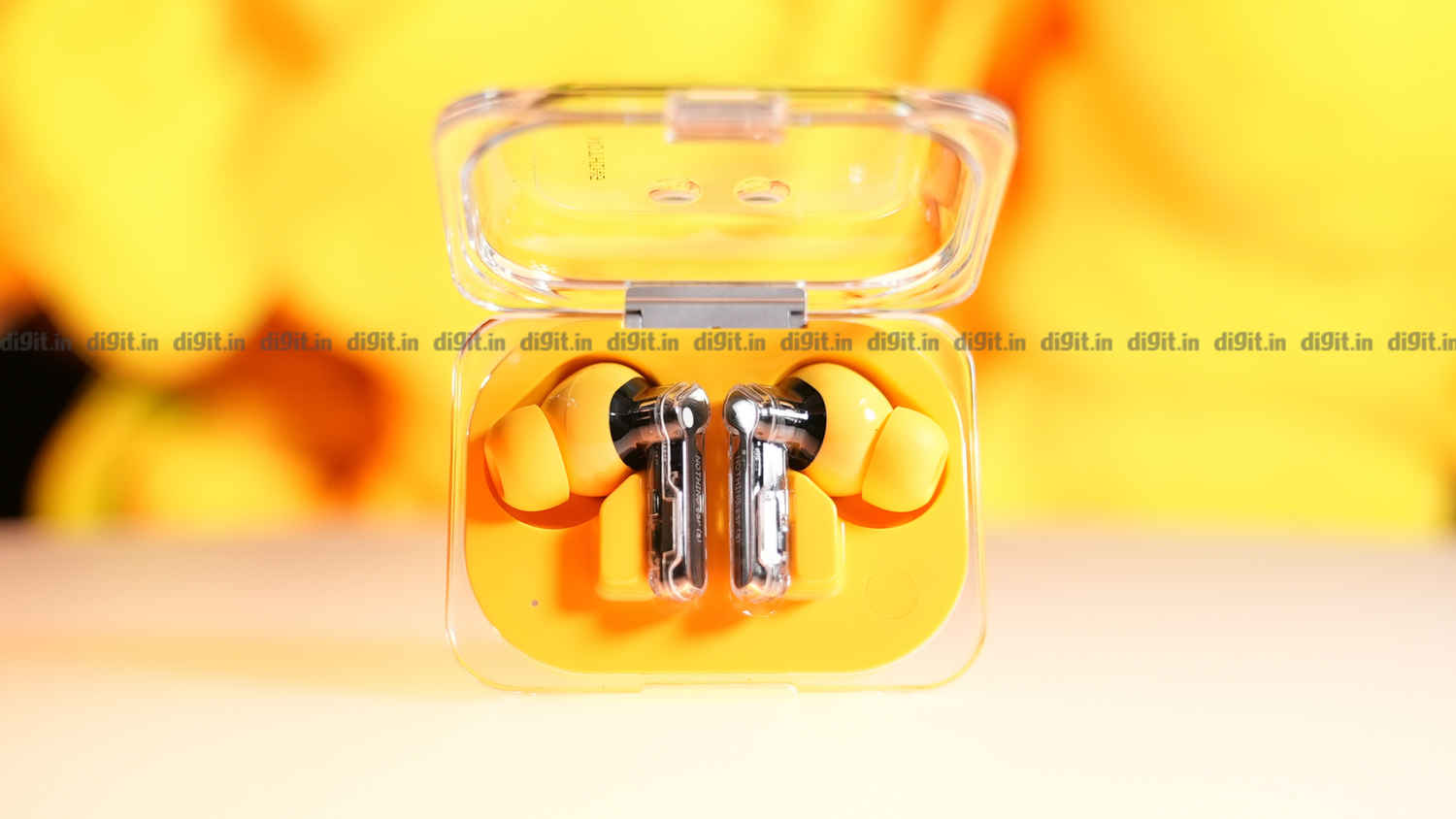
It is a sleek, lightweight case, with great pocketability. You see a lip around the seam of the case, which is not my favourite because it got stuck on my pocket seam whenever I was pulling these in-ear earphones in and out of it. But others at the Digit Test Centre did not mind it as much. The case has a transparent design, giving us a peek into the insides. These in-ear earphones are available in three colours – white, black, and yellow. The inner cavity of the case carries the single solid colour of your choice, and the buds complement it. If you go for the black variant, you have the shell of the buds with a black tint finish.
The case has a nice heft, which matches its price tag, giving it a premium feel in the hands. The magnets holding the buds in place and the lid closed are fairly strong. There is not much to complain about. You can open the case with one hand, and the hinge, which is metal (love that), is snappy and holds its own. And, not to forget, my personal favourite, the pairing button. You have it on the case, like all other Nothing in-ear earphones. Now, moving on to the buds.
The Nothing Ear (a) is a pair of TWS in-ear earphones that will not leave much to complain about the fit, for many people who buy it. The fundamental design of the buds remains the same as that of the Nothing Ear (1) and the Ear (2). You get three ear pairs of ear tips in the box, so you are covered on that front as well. The buds are lightweight, fit well, and the pinch controls are positioned well, leaving very few things to complain about. The colour scheme on the buds, coupled with the slick and minimalist branding on the stem, add a few brownie points in the bag of these in-ear earphones.

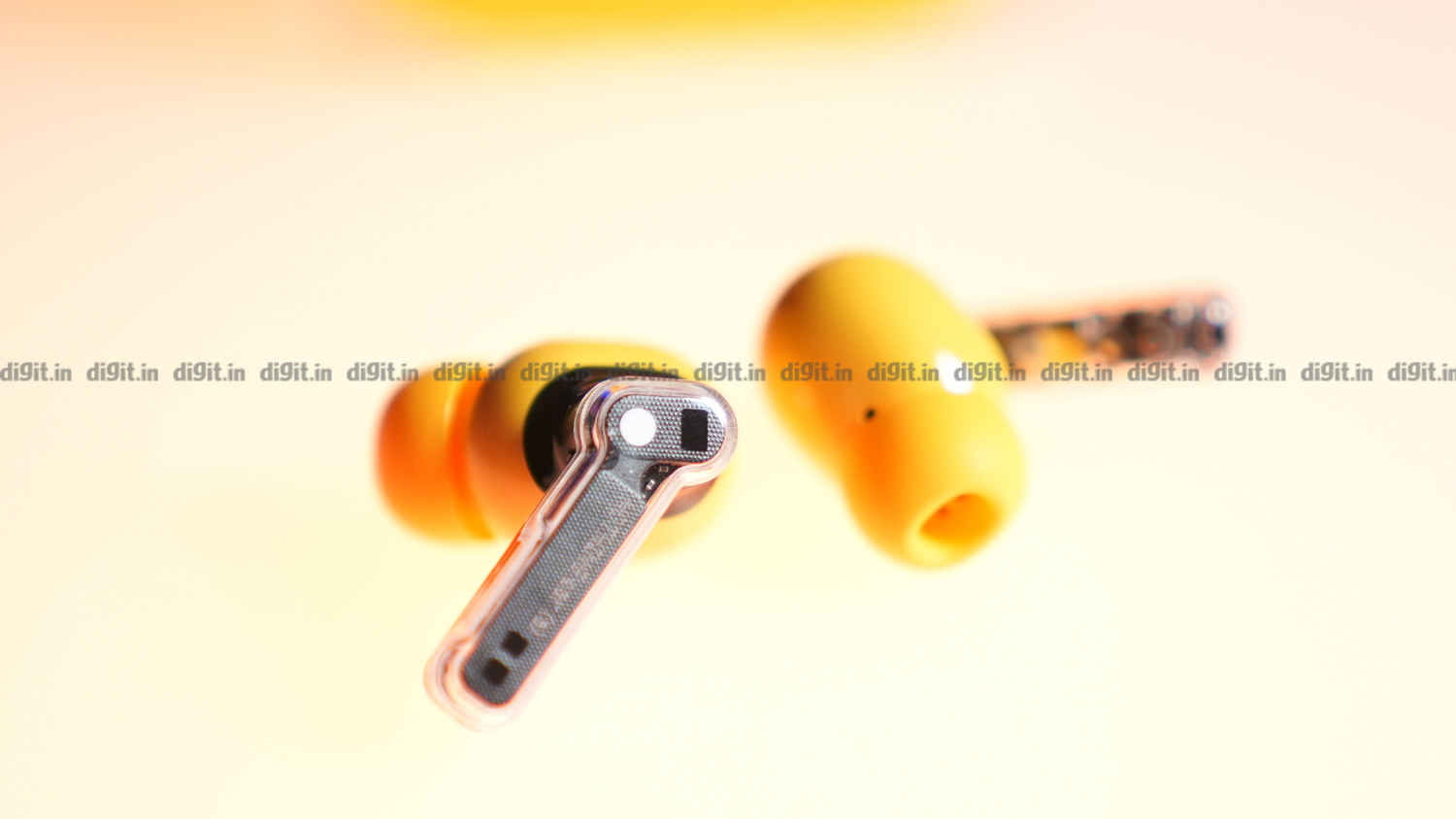
Before moving ahead, the regular reminder for anyone reading the review – Everything in the world of audio products is very subjective, including the fit of the in-ear earphones. So, I would recommend you try out the buds for yourself before going forward with your purchase.
However, while the colour scheme and design, for the most part, may be palatable for the folks willing to experiment with the looks of the buds, many who have a more traditionalist approach will find it a bit too overwhelming. The added lip and the flashy yellow colour options are some things that might draw people away from these in-ear earphones. Add to that the scratch-prone body of the case and the buds themselves, and these in-ear earphones seem to fall off a lot of people’s lists, who might have been drawn to the product because of its design.
Apart from this, there is not much to complain about the build and design of the Nothing Ear (a). You get IP54 water resistance on the buds and the case also, to my surprise, boasts a respectable IPX2 water resistance. I don’t know how they managed it, but it is a definite nice to have.
Features are a plenty!
Nothing has loaded these in-ear earphones with features. Nothing Ear (a) comes with the following features –
- ChatGPT support (works with Nothing phones only)
- Microsoft Swift Pair and Google Fast Pair
- Find my in-ear earphones
- Customisable EQ in the Nothing X app and Bass Enhance algorithm
- In-ear detection
- Low latency mode
- Hi-Res CODEC support
- Smart Active Noise Cancellation with transparency mode
- Clear Voice Technology, and more
Now, let’s talk about each of them one by one. First off, ChatGPT support.
Every manufacturer in the consumer technology space is rushing towards getting the AI label slapped on their products. And, the ChatGPT integration, which, to my annoyance, works only with Nothing Phones, is one such move from Nothing. It definitely is responsive and works well, and for the fans of AI-powered assistants and generative models, it is a great addition to the product. However, Nothing, in my opinion, should have baked it into the Nothing X app itself to make it more accessible to people outside of the upcoming “Nothing Ecosystem”. They might not label it, but it is coming, and I see the sprouts of the same in the form of features like this.
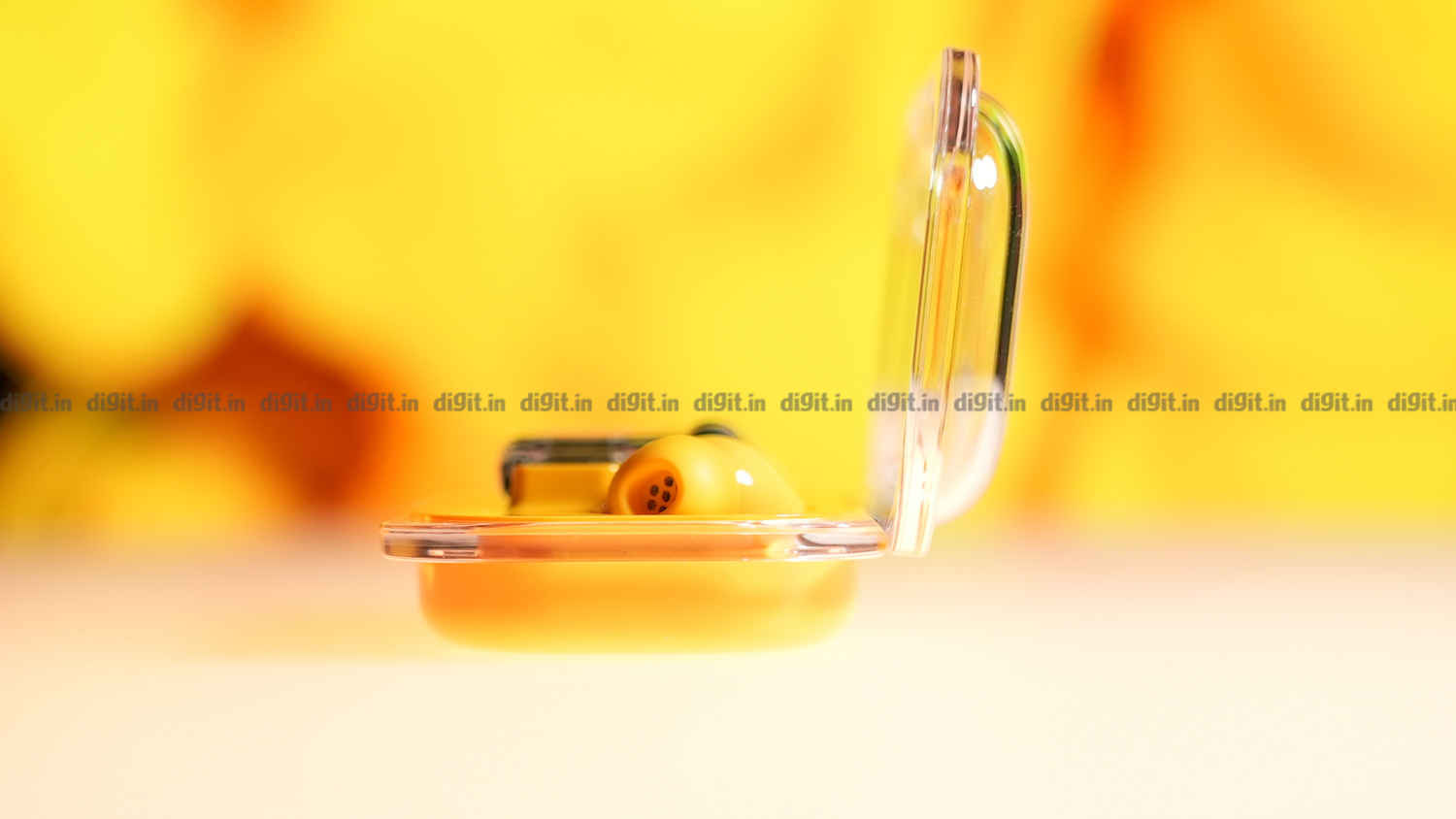
Moving to Microsoft Swift Pair and Google Fast Pair. Coupled with the dual device connectivity option that this device offers, makes it a seamless experience; pairing the in-ear earphones to a phone and PC, in my experience, worked wonders. Most brands these days offer only Google Fast Pair, and the inclusion of Microsoft Swift Pair makes life easy for the folks using a Windows PC, and Android phone. For the folks who are tied into the Apple Ecosystem, like me, it is a slightly long-drawn process to pair and manage the connectivity between the two devices. This is when you will start to love the pairing button.
Nothing Ear (a) comes with support for the Nothing X app, which adds a bunch of necessary features to the device. The design of the app is awesome, and in my review of the Nothing Ear (2) and Dhriti in her review of Nothing Ear (2024), have written loads about the same. Let’s move to the features that are packed into the Nothing X app.
First off is the customisable EQ. You get two modes when you are working with the EQ – simple and advanced. Adding an EQ in the first place is a great addition to the buds, given the nature of their sound signature (more on that later). However, having two different modes makes this customisation layer more accessible to everyone, and I love it. The simple EQ has three bands for you to work around, with each band having a five-step customisation option. When you switch to the Advanced mode, you get 8 bands to play with and tons of other options, which make it an audiophile’s dream. We have written home about the companion apps offered by brands like Sony, but Nothing has done something truly special with these in-ear earphones.
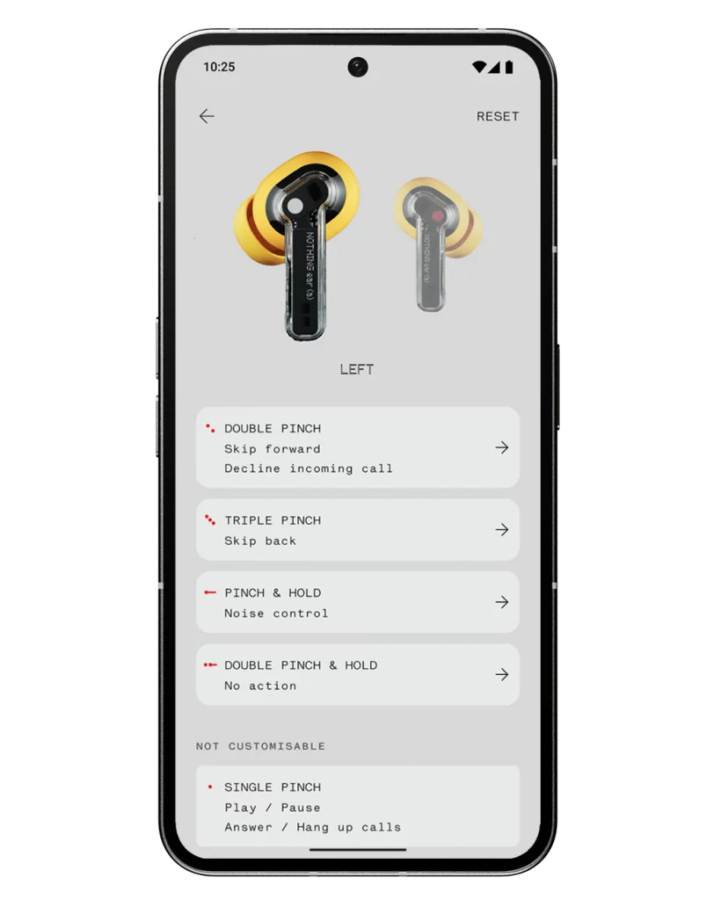
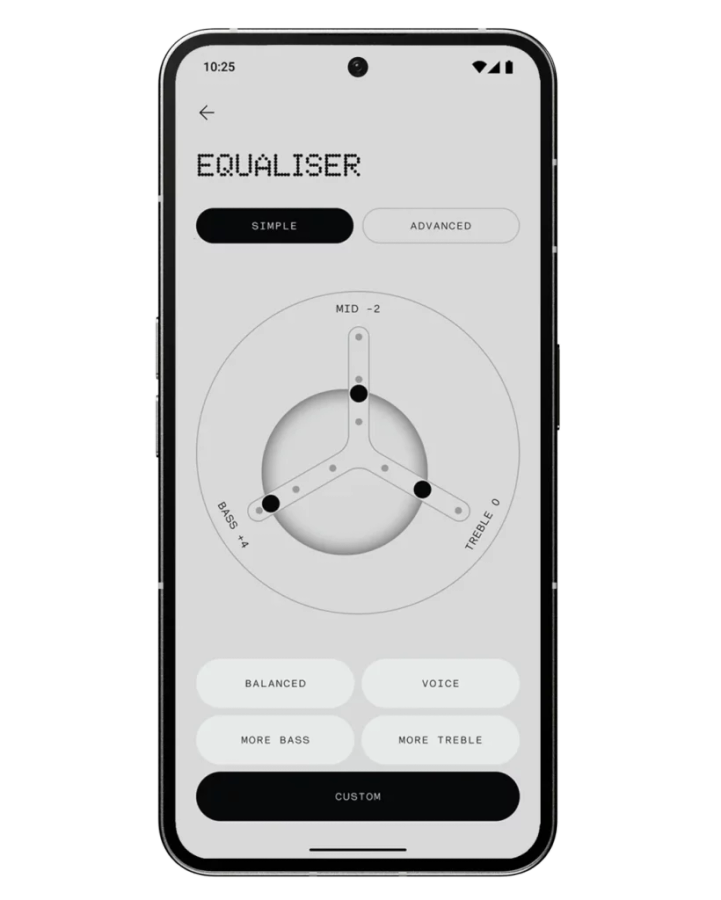
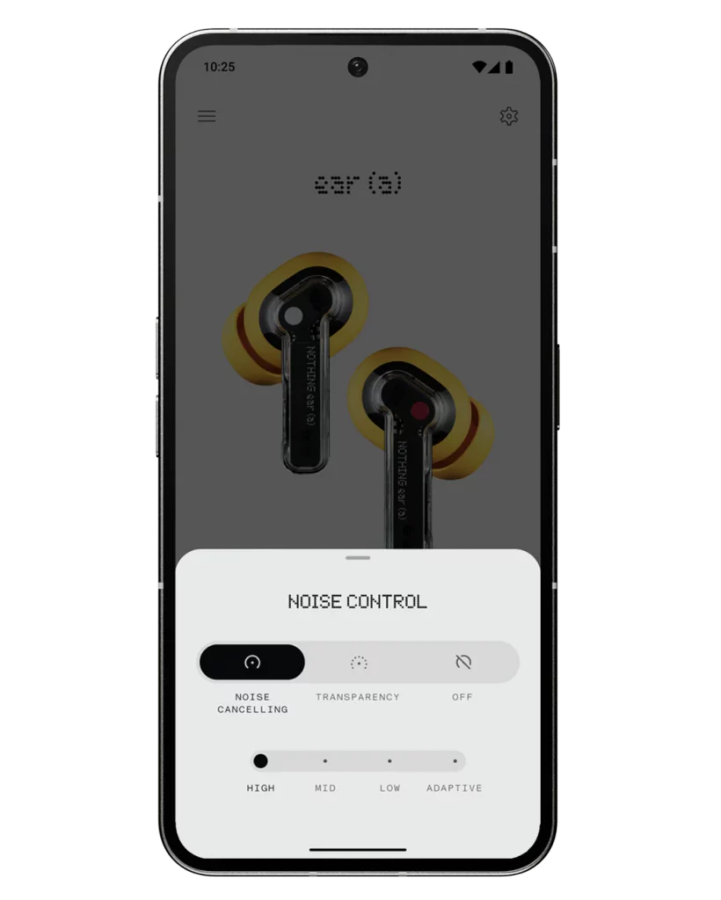
In addition to the customisable EQ, you can also customise the ANC (with a 4-step customisation option) and transparency mode and make tons of other customisations to ensure that these in-ear earphones are truly your own when you use them. Everything from controls to the Bass Enhance feature is definitely something that makes your experience much better overall. Additions like low-latency mode for gamers and clear voice technology, which is supposed to make your calls sound better, all add to the overall user experience. Home run scored in this department.
Lastly, in this long list of features, I would like to talk about the Hi-Res CODEC support offered by these in-ear earphones. While I would hold off on giving my word about the sound signature of these buds right now, the addition of these CODECs, which includes LDAC, ensures that people streaming high-quality music get the most out of these in-ear earphones. We have seen some in-ear earphones in the same price range skip out on adding high-quality CODECs to their products, so having this is great!
Now, let’s move on to the sound signature and performance of these in-ear earphones.
Nothing Ear (a) — Performance
Nothing Ear (a) lost the most ground in terms of their performance. At the Digit Test Centre, we compare every piece of audio equipment that comes in against the flat benchmark sound signature recorded by us using Pink Noise. And, due to their bass-forward sound signature, the Nothing Ear (a) lost a fair bit of points in our scoring. As you can see below, the sound signature of Nothing Ear (a) has a lot of bass extension, and its over-emphasised nature makes the sound muddy and boomy. It is not as bad as what we experienced in the Moto Buds Plus, but it does lean into the mids and highs. There is detail in the sound; however, in certain specific scenarios, like action sequences in movies, dialogues might get muffled a little bit.
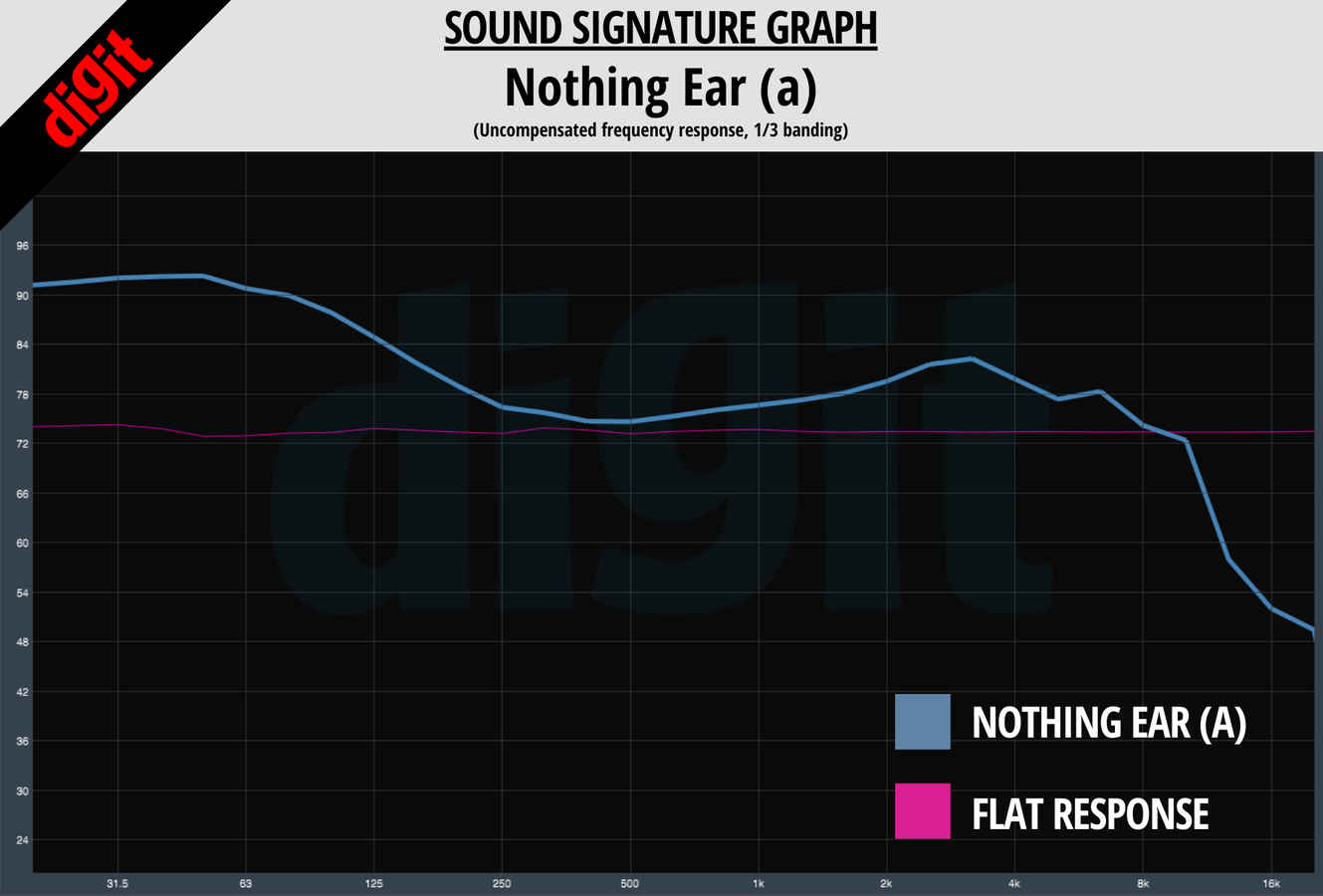
In tracks like Uptown Funk by Bruno Mars, you will enjoy this extended bass response, especially if you are someone who considers yourself a “bass-head”. For others, you might feel that the bass is a bit too overwhelming out of the box. Surprisingly, the bass enhance mode tamed it down quite a bit. And, if you are someone who is not comfortable working with the inbuilt EQ, then you would definitely be able to manage with this mode turned on.

But, if you are planning to tinker with the EQ, then I would recommend turning the bass down by almost half in the simple EQ mode. But, then again, that is my preference. The only word of caution that I would like to give you is the bass response is more than what you would expect, so tread with caution. Bass lovers, go all in.
When pitted against similarly priced offerings like the Sony WF-C700N and the Audio-Technica ATH-SQ1TW, these in-ear earphones pale in comparison to the much more well-rounded sound of the other two buds. You can see the difference in the overall consistency and balance in the sound signature of the other two buds.
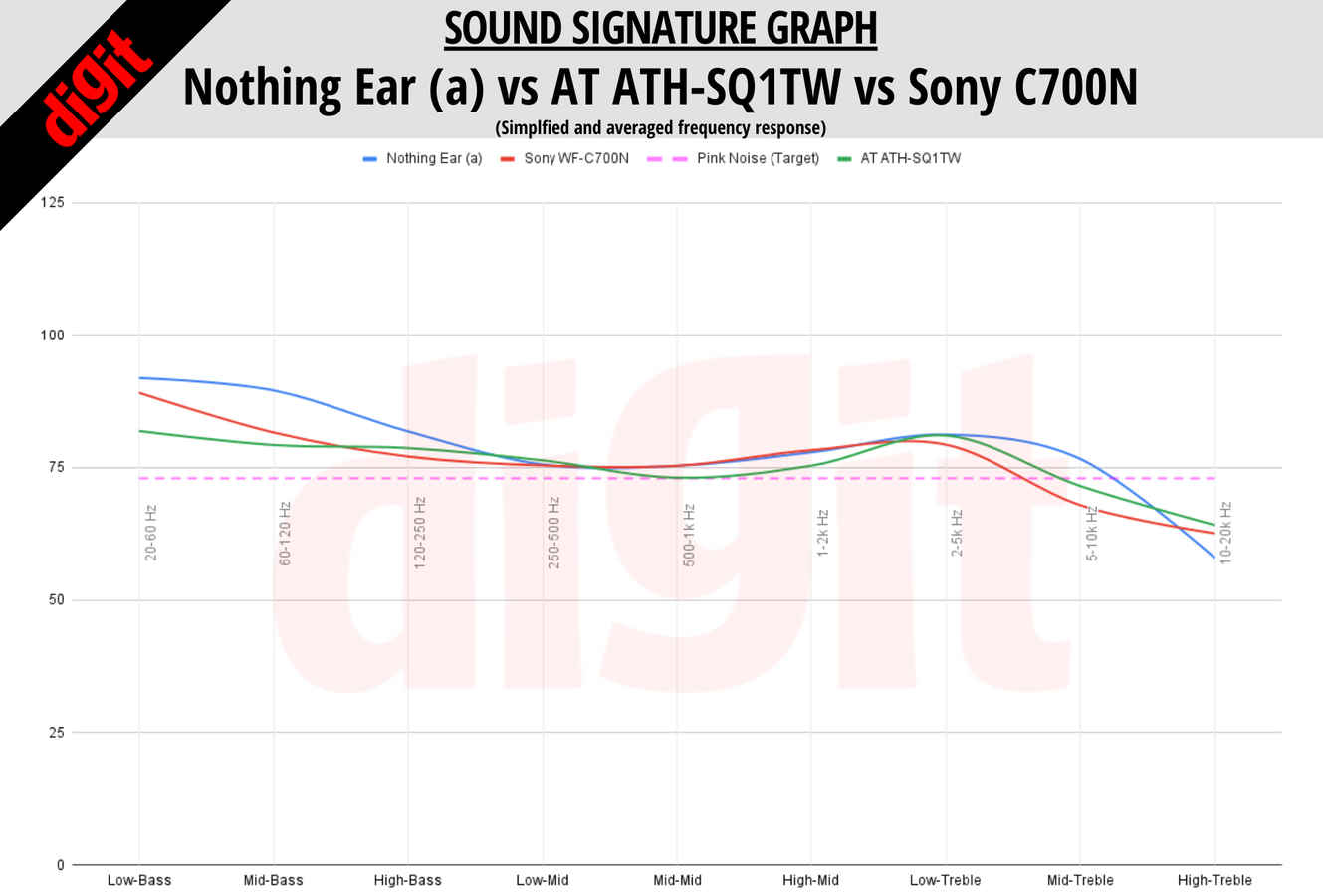
Keep in mind that the Audio-Technica ATH-SQ1TW lack a lot of features that the Nothing Ear (a) comes packing with, and the Sony WF-C700N will mostly be on the pricier side during the sale season. But the Sonys do make for a strong case for themselves. And, if you are looking at the Nothing Ear (2024), out of the box, these in-ear earphones pale in comparison, but with some changes in the EQ, you will definitely get pretty close in terms of performance. So, you can save a buck or two with these in-ear earphones over the Nothing Ear (2024).
Coming to the ANC and transparency mode. The tone was set by the Nothing Ear (2024) when it came to ANC performance. I went in with no bias in my head but quickly realised that the ANC performance of these in-ear earphones is almost the same as that of the Nothing Ear (2024). While for those in-ear earphones that are priced slightly higher, and suffer a lot due to the dip in the ANC performance, these in-ear earphones do not get penalised as much.
When ANC is turned on and set to max, you will not hear almost any low-end sounds, including ones like the humming of ACs or the ambient humming sounds in aircraft. When faced with more challenging scenarios where the sound coming in is more irregular, for example, in traffic or when someone is typing on a loud keyboard around you, these in-ear earphones tend to struggle a bit. You will get irregular spikes in the sound levels, which I believe can be easily polished out with a firmware update. Let’s hope for the best here.
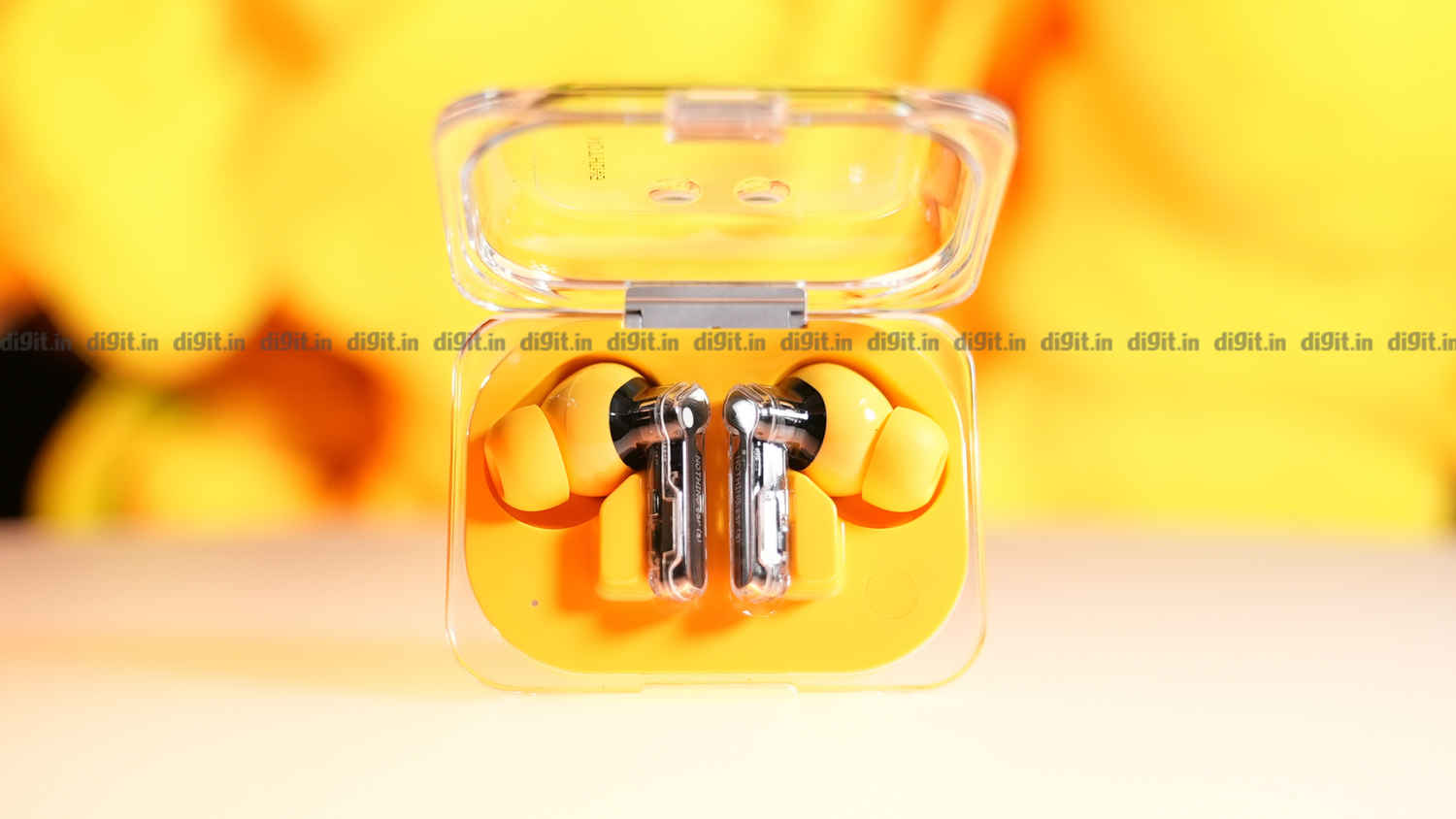
The microphones on these in-ear earphones also hold their own when it comes to indoor and relatively silent spaces. The clear voice tech that Nothing has packed in ensures that your voice goes through clearly. In noisy environments, the in-ear earphones tend to struggle a little bit, letting in some of the ambient noise; however, the performance was passable overall.
Battery life galore!
The battery life of the Nothing Ear (a) pack is also something that I was pleasantly surprised with. In my tests, with ANC on and volume set to 50 per cent, these in-ear earphones were able to manage a total battery life of 5 hours and 15 minutes, with the case providing for four more rounds of charging. This brings up the battery life of these in-ear earphones up to 21 hours in total with some juice left in the case.

This gives them a lead over the Sony WF-C700N and the Audio-Technica ATH-SQ1TW, which lasted for 14 hours and 18 hours, respectively, in the same conditions. And, when you are out of charge, you can get up to 10 hours of playback in just 10 minutes of charge, as claimed by the brand. So, that is something to definitely keep in mind when you are making your purchase decision.
Should you buy the Nothing Ear (a)?
Nothing Ear (a) makes for a compelling option for people looking for a pair of TWS in-ear earphones with ample, well-implemented features, and if you are a fan of bass-heavy music or if you are someone who is willing to play around with the EQ to ensure that you get the sound that you desire. Out of the box, their sound is bass-heavy, and might not appeal to the purists, but the EQ in the Nothing X app, and the overall customisation experience provided by the app, definitely make up for all the lost ground.
If you are looking for alternatives, then the Audio-Technica ATH-SQ1TW and the Sony WF-C700N are your best bets. Both are priced similarly to the Nothing Ear (a). The Audio-Technica ATH-SQ1TW offer much better sound out of the box, but they trade out a lot of features that you get with the Nothing Ear (a). The Sony WF-C700N, offer similar sound out of the box and features. With those earbuds, the only place where you would be left in splits would be the aesthetics. And, that is up to you.
Coming to their pricier cousins, the Nothing Ear (2024), you get the extra bit for which you would pay. So, if you have the budget, go for them over the Nothing Ear (a). However, read our review before doing it!
Nothing Ear (a) Key Specs, Price and Launch Date
| Release Date: | 06 Jun, 2024 |
| Market Status: | Launched |
Key Specifications
Dimensions
30.9 x 21.7 x 24.3
Satvik Pandey
Satvik Pandey, is a self-professed Steve Jobs (not Apple) fanboy, a science & tech writer, and a sports addict. At Digit, he works as a Deputy Features Editor, and manages the daily functioning of the magazine. He also reviews audio-products (speakers, headphones, soundbars, etc.), smartwatches, projectors, and everything else that he can get his hands on. A media and communications graduate, Satvik is also an avid shutterbug, and when he's not working or gaming, he can be found fiddling with any camera he can get his hands on and helping produce videos – which means he spends an awful amount of time in our studio. His game of choice is Counter-Strike, and he's still attempting to turn pro. He can talk your ear off about the game, and we'd strongly advise you to steer clear of the topic unless you too are a CS junkie. View Full Profile



